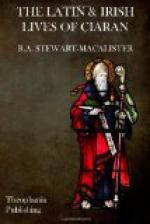The Hide of the Cow.—Plummer quotes other illustrations of such mechanical passports to the Land of the Blessed (VSH, i, p. xciii). The main purpose of this whole incident is doubtless to explain the origin of a precious relic, preserved at Clonmacnois. Its history is involved in some doubt: it is complicated by the fact that there exists a well-known manuscript, now preserved in the library of the Royal Irish Academy, written at Clonmacnois about A.D. 1100, and called the Book of the Dun Cow, from the animal of whose hide the vellum is said to have been made. But whether this book has any connexion with the Dun Cow of Ciaran may be considered doubtful. For down to the comparatively late date at which our homilies were put together, the hide of Ciaran’s Dun was evidently preserved as a hide, on or under which a dying man could lie: therefore it cannot have been made into a book. Yet Imtheacht na Tromdhaimhe (p. 124 of the printed text) tells us, for what it may be worth, that Ciaran wrote the great epic tale called Tain Bo Cualnge upon the hide of the Dun Cow. There is actually a copy of this tale in the existing book; but the book was written not long after the time when our homilists were describing the relic as an unbroken hide. Either there were two dun cows, or the name of the Manuscript has arisen from a misunderstanding.
The stanza in VG is another example of ae freslige metre. The literal translation is “Fifty over a hundred complete / the Dun of Ciaran used to feed, // guests and lepers / people of the refectory and of the parlour.”
The School of Findian.—Findian was born in the fifth century. He went to Tours for study, and afterwards to Britain; he then felt a desire to continue his studies in Rome, but an angel bade him return to Ireland and there continue the work begun by Patrick. After spending some time with Brigit at Kildare, and establishing various religious houses, he settled at Cluain Iraird, in the territory of Ui Neill: now called Clonard, in Co. Meath. His establishment there became the chief centre of instruction in Ireland in the early part of the sixth century. He died in 549, at an advanced age: indeed, he is traditionally said to have lived 140 years. Nothing now remains of the monastery, though there were some ruins a hundred years ago.
XVIII. THE ANGELS GRIND FOR CIARAN (LA, LC, VG)
The angels grinding have already been seen in incident XIV.
The Stanza in VG.—This is in the metre known as rannaigecht mor, seven syllables with monosyllabic rhymes, usually abab. The translation adequately expresses the sense and, approximately, the metre.[16] The number of saints enumerated is thirteen, not twelve, but the master, Findian of Clonard, is not counted in the reckoning. The names, the principal monasteries, and the obits of these saints are as follows—




